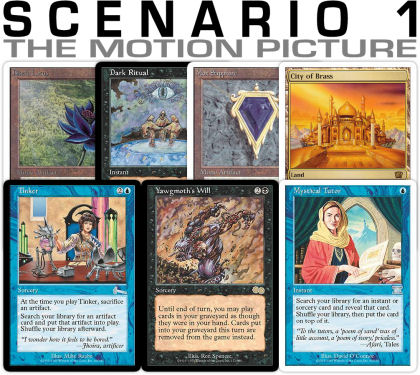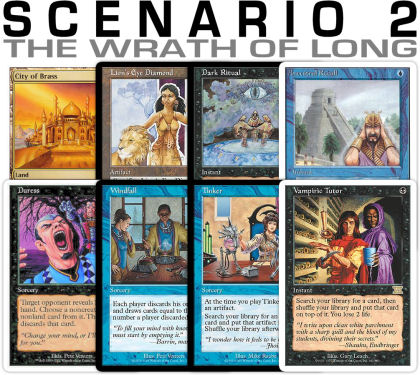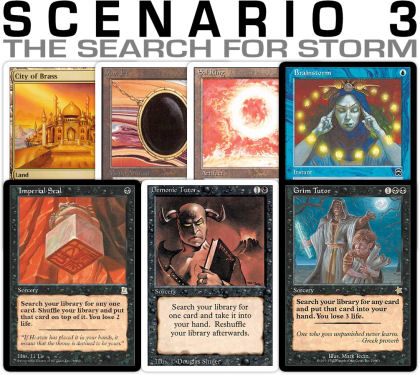My favorite deck in the format right now, by a long shot, is Grim Long. I’m sure it has something to do with the fact that I’ve been playing Long variants since 2003, and this one is as close as we can get to the deck that got two cards restricted.
Grim Tutor is a real powerhouse right now. Storm combo went from being unplayable in Vintage, way behind Mana Drains and Stax, to what appears to be a stable Tier 1 position. Team GWS has invented what they call “intuition tendrils” and my team, Meandeck, came up with Grim Long.
The best part about these decks is that they will never dominate because they are prohibitively difficult to master. Grim Long has about the closest relationship between skill and performance that I can see. If you are terrible, the deck will perform horribly. If you are mediocre, the deck will perform correspondingly. If you are amazing, Grim Long will be a shining star for you.
For me, the fun comes from the fact that most games are a unique experience, since you play with so many restricted cards. You could play the deck a hundred times, and in your next 100 games come into dozens of Rosewater Puzzling type scenarios that you need to work your way out of. However, it’s those medium-hard level puzzles and not those inanely hard ones. For that reason, this deck is actually playable in Vintage, as opposed to say, Meandeck Tendrils (insert link). The deck is also jam-packed with broken cards, so that makes your burden a bit easier.
In this article, I’m going to discuss a few situations that have come up in testing and evaluate how to play them properly.
Let’s get into them.

Scenario One:
Black Lotus, Dark Ritual, Mox Sapphire, City of Brass, Tinker, Yawgmoth’s Will, and Mystical Tutor.
This hand came up in a game I played at a small tournament in Dayton. This hand is not particularly difficult to play, but it helps us illustrate a number of hidden principles about playing Grim Long.
This hand already has Yawgmoth’s Will in hand. It seems obvious that your goal is to resolve Yawgmoth’s Will.
However, it also has Tinker. Your primary Tinker target is Memory Jar. How will you get Memory Jar and Yawgmoth’s Will to interact? One option is to Tinker up the Jar and then play Yawgmoth’s Will, and respond by breaking the Jar. Such lines of thought are dangerous because they are irrelevant.
It is clear that you are going to play:
Mox Sapphire, City of Brass, Dark Ritual, and Tinker.Â
Consider what happens next.
If the Tinker is countered, then you can bet that your Yawgmoth’s Will will resolve. If Tinker resolves, then I know they don’t have a counter.
If Tinker is countered, then you resolve Will and replay the Ritual and the Lotus, Tinker up Jar, and Mystical Tutor for Tendrils, break Memory Jar and hope to draw two mana sources to kill them. There might be a better play than Mystical Tutor for Tendrils here.
If Tinker resolves, then there is no reason to fetch out Memory Jar. In the tournament game, Tinker was not countered, so I found Lion’s Eye Diamond. I played Yawgmoth’s Will and broke the LED in response. I replayed the LED and Black Lotus and Tinkered up Memory Jar, Mystical Tutored for Tendrils, and broke the Jar to play the Tendrils.
The point of this scenario was to illustrate how Tinker can function in multiple ways. Here, it functions as a quasi Duress, providing you crucial information. If it resolves, you definitely win. If it doesn’t resolve, you probably win anyway. It’s just a matter of thinking about the consequences of its resolution.

Scenario Two:
Ancestral Recall, Duress, City of Brass, Windfall, Lion’s Eye Diamond, Tinker, Dark Ritual, and Vampiric Tutor.
When this hand came up, it was a matter of considerable debate on team. JD, an expert with Storm combo, expressed his view that this hand may not be keepable, particularly if he was going to game 3. I am inclined to agree that this hand does have a critical bottleneck. However, the hand presents had a fundamental question that recurs the more you play the deck:
When you have Duress, Land, and Ancestral, which do you play on turn 1, assuming you can only play one and not both?
There are several distinct possibilities.
The obvious play is to Duress immediately, take their strongest card, and hope that next turn Ancestral will resolve or will just bleed their answers/threats.
The slightly more sophisticated play is to drop the City of Brass, pass, and then Ancestral on their end step. Then if they Force of Will it, I could Duress them on my second turn and take their strongest card and then subsequently Vampiric Tutor for a threat and play it. This plan has the best chance of beating both Force of Will and Mana Drain.
On the other hand, wouldn’t the logic of that play equally suggest that you just play turn 1 Ancestral? If you are going to play Ancestral anyway, the only reason to not play it immediately is to try and bait any countermagic out, not just Force of Will. If you play it immediately, they have a lesser probability of having seen Force of Will than if you wait until their end step. If they Force of Will the Ancestral, then the result is the same. But if they don’t, then you got more threats out of the deal, and you may be able to just win before even passing the turn.
This hand came up in a test game, and in a tournament situation, a very similar situation arose. I had a hand with Land, Ancestral, and Duress and I played the Ancestral, which resolved, and I won the game.
There is a fourth play. This is the play that JD identified later on and a play that I have come to see as probably the best play:
In JD’s words:
I play City of Brass and pass. End of turn, I play Vampiric Tutor for Lotus. Then I lead with Dark Ritual and see if that resolves. Then Lotus, Ancestral Recall, go from there. The Ritual is more likely to be countered if I play it first (and it is the card I need to resolve least in this string), meaning I don’t have to use Duress if it doesn’t resolve. If it does resolve, then I soooo win this game.Â
I get to Duress, use Ancestral Recall to strip out any remaining countermagic, and then play Tinker for Jar (sucks to sac LED though), and then crack it that turn with the storm at 6 or so before I’ve even played a land, with B still floating to boot. I have to take the chance that if my opponent has both Force of Will and Mana Drain in his hand, I’m in big trouble. But I knew that, because this hand loses to an opposing hand like that because it has practically zero mana. Of course, if I drew a Mox for my turn, it would be almost statistically impossible to lose, as I get LED still around, meaning I have UBBB going into my Jar with the storm at 6 or 7.
I agree pretty much with the substance of what he said.
I think the best play, particularly if you are on the play, is to play the land, pass, and then cast Vampiric Tutor at the end of turn for Lotus so that you can play:
Dark Ritual
Black Lotus
Ancestral Recall
I think the key difference between JD and myself, however, is that I would probably go: Ritual, Duress, unless I really felt that they didn’t counter the Dark Ritual because they don’t have any countermagic. It is certainly plausible, in my view, that they may not counter the Dark Ritual because they suspect that you have tutored for Black Lotus or a bomb. Thus, I would likely play the Duress to clear the way. After your Ancestral resolves, you still have four mana floating. If you see a Mox or an artifact, you can Tinker that away for Jar and break the LED and Jar with lots of mana floating, practically a guaranteed win.
I think either turn 1 Ancestral or on your opponents first end step Vampiric Tutor for Lotus is the correct play. It’s a close question though and one worth debating further.

Scenario Three:
This hand is probably one of the more difficult hands I’ve ever seen with Grim Long, and that’s saying something. I was playing against Control Slaver and I was on the play. This was a game 1 scenario:
City of Brass
Brainstorm
Mox Jet
Sol Ring
Imperial Seal
Demonic Tutor
Grim Tutor
Immediately, you are presented with a multiplicity of options.
You can play:
1) Turn 1 Brainstorm (and Sol Ring)
If you play turn one Brainstorm, the remaining series of plays hinges entirely on what you see with Brainstorm, so let’s remove that option from the table for the moment.
2) Turn 2 Imperial Seal (following or preceding Brainstorm)
If you play Imperial Seal first, then you have two possible subsequent plays. The first is to play Land – Brainstorm or Land – Sol Ring. Depending on what you tutored for or what you saw with Brainstorm, you may be able to continue to play more spells this turn. The card that generates you the most mana is Black Lotus. However, analyzing what you can do from this position also depends on what you see with Brainstorm.
3) Turn one Demonic Tutor
If you play Jet, Sol Ring, Land, Demonic Tutor, the most you can do in terms of generating mana is to play Black Lotus. At this point, you could then play Black Lotus and sacrifice it for Black and play both Grim Tutor and Imperial Seal, hoping to set up a broken turn 2 series of plays. God knows what though.
In the actual game, I decided I was going to Brainstorm before doing anything. I saw:
Dark Ritual
Wheel of Fortune
Time Walk
So you have in hand:
Sol Ring
Demonic Tutor
Imperial Seal
Grim Tutor
Dark Ritual
Wheel of Fortune
Time Walk
And you need to put to cards back.
Here is what my teammates had to say:
Doug Linn, a.k.a. Hi-Val:
It’s one mana short of being able to go get Lotus and Will and win on the spot. I see what you mean about it being difficult. I think that one at this point plays the Jet and Ring and Rits and then DTs for Lotus and Wheels.
This play seems meritorious to me. If Wheel resolves, great. If not, you still have outs and next turn you can play Tutor and Time Walk and then hope to play a bomb or two.
Willy came up with the following play:
Play for Wheel, putting back Grim Tutor and Time Walk. Play Jet, Imperial Seal for Lotus and pass. Your hand is now
Wheel
DT
Lotus
Ritual
Sol Ring
Lead with Ritual, DT, Lotus, Necropotence. Force of Willed? Follow with Sol Ring, Wheel.
This play is also fun because it bets countermagic. The flaw is that your Wheel will resolve with no spare mana floating, however, you haven’t played a land yet this turn. That means that you will have the possibility of dropping a land and playing more threats.
Jacob Orlove came up with the following, a completely different solution:
Okay, if put back Grim and Walk.
Jet, Ritual, Sol Ring. 2BB Floating.
Demonic for Lotus. 1B Floating.
Imperial Seal for Regrowth, sac Lotus for RRR.
Wheel, R floating, draw Regrowth and 6 other cards. Between ESG, Petal, and Emerald, we have about a 40% chance of seeing a green source and getting back Lotus, which is better odds than just Petal and Jet for a Ritual. Sadly, Lotus is the only way to get at least 1R out of Demonic, so it’s not available as a Seal target. If Sol Ring was a colorless Mox, we could float B into wheel and have Cabal Ritual on top, but that’s also not an option.
If we don’t get a Green source, we have to pass the turn, but next turn we have 2BG available with Regrowth and 6 cards, and a fully stocked graveyard, which seems promising.
If they Force the Lotus (which is pretty clearly the optimal target), then we can just Seal for something good and pass. Probably just Will, and if they counter it, wheel on turn 3.
This is also an intriguing series of plays. Props to Jacob for thinking outside of the box.
I think a problem with all of these plays, however, is that they are underestimating the power of Time Walk.
Here is one play that I came up with:
You put back Grim Tutor and Wheel
You play Jet, Ritual, Sol Ring, DT for Lotus, B1 floating. Break Lotus for UUU and play Time Walk. Play Imperial Seal for Yawgmoth’s Will.Â
Your yard has Black Lotus, Dark Ritual, Demonic Tutor, Imperial Seal and Brainstorm, you can then Imperial Seal for Lion’s Eye Diamond and then Brainstorm into it. Then you’ll have seven mana and one storm short of being able to lethal tendrils – if you see any accelerant off the brainstorm you can win.Â
Clearly, there are many possible plays with this hand. I have not tried to definitely answer the question of which play is correct, because honestly, I’m not sure that I know.
Each of the hands I have presented here brings into focuses very different but equally important issues with this deck. Hopefully we have gained some insight into the nuances of Grim Long.
Until next time
Stephen Menendian
